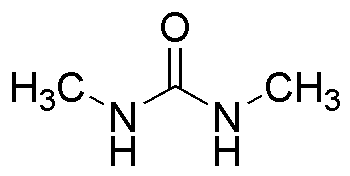1,3-Dimethylurea is widely utilized in research focused on:
- Agriculture: It serves as a nitrogen source in fertilizers, promoting plant growth and enhancing crop yields.
- Pharmaceuticals: This compound is used in the synthesis of various medicinal agents, contributing to the development of new drugs.
- Polymer Science: It acts as a building block in the production of polymers, improving material properties such as strength and durability.
- Biochemistry: Researchers utilize it in studies related to enzyme activity and protein interactions, aiding in the understanding of biological processes.
- Environmental Science: It is employed in the formulation of biodegradable materials, addressing sustainability challenges in various industries.
General Information
Properties
Safety and Regulations
Applications
1,3-Dimethylurea is widely utilized in research focused on:
- Agriculture: It serves as a nitrogen source in fertilizers, promoting plant growth and enhancing crop yields.
- Pharmaceuticals: This compound is used in the synthesis of various medicinal agents, contributing to the development of new drugs.
- Polymer Science: It acts as a building block in the production of polymers, improving material properties such as strength and durability.
- Biochemistry: Researchers utilize it in studies related to enzyme activity and protein interactions, aiding in the understanding of biological processes.
- Environmental Science: It is employed in the formulation of biodegradable materials, addressing sustainability challenges in various industries.
Documents
Safety Data Sheets (SDS)
The SDS provides comprehensive safety information on handling, storage, and disposal of the product.
Product Specification (PS)
The PS provides a comprehensive breakdown of the product’s properties, including chemical composition, physical state, purity, and storage requirements. It also details acceptable quality ranges and the product's intended applications.
Certificates of Analysis (COA)
Search for Certificates of Analysis (COA) by entering the products Lot Number. Lot and Batch Numbers can be found on a product’s label following the words ‘Lot’ or ‘Batch’.
*Catalog Number
*Lot Number
Certificates Of Origin (COO)
This COO confirms the country where the product was manufactured, and also details the materials and components used in it and whether it is derived from natural, synthetic, or other specific sources. This certificate may be required for customs, trade, and regulatory compliance.
*Catalog Number
*Lot Number
Safety Data Sheets (SDS)
The SDS provides comprehensive safety information on handling, storage, and disposal of the product.
DownloadProduct Specification (PS)
The PS provides a comprehensive breakdown of the product’s properties, including chemical composition, physical state, purity, and storage requirements. It also details acceptable quality ranges and the product's intended applications.
DownloadCertificates of Analysis (COA)
Search for Certificates of Analysis (COA) by entering the products Lot Number. Lot and Batch Numbers can be found on a product’s label following the words ‘Lot’ or ‘Batch’.
*Catalog Number
*Lot Number
Certificates Of Origin (COO)
This COO confirms the country where the product was manufactured, and also details the materials and components used in it and whether it is derived from natural, synthetic, or other specific sources. This certificate may be required for customs, trade, and regulatory compliance.


